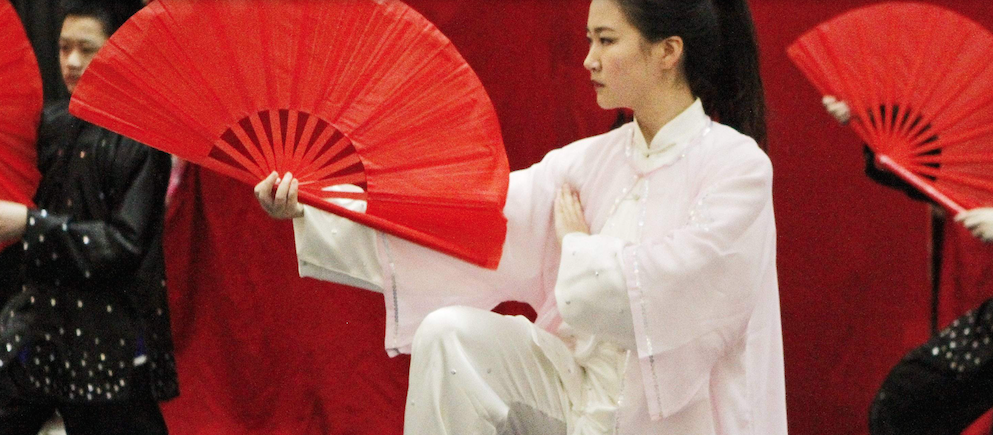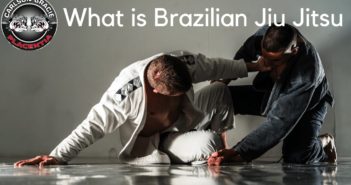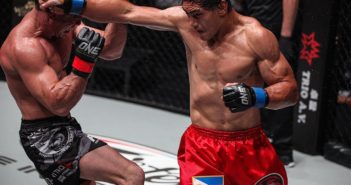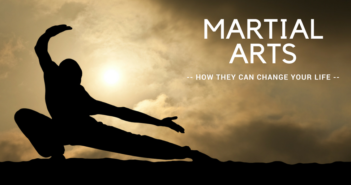In 1954, at the Museum of Modern Art in New York City, a 51-year-old woman in loose, comfortable clothing moved through a series of movements. A crowd gathered amidst abstract paintings to watch her. With the grace of a dancer, she slowly raised and lowered her hands, shifted her weight from side to side, and bowed her head. Her face was calm and serene. This is the story of how an American dancer introduced Taichi to America.
An American dancer
The woman’s name was Sophia Delza. She was a dancer of some renown in the world of modern dance. When she first performed solo at the Guild Theater in New York at age 27, the New York Times called it “a distinguished debut” that “revealed her as an artist of individuality and authority.”
Although the woman’s slow pace would have bored a concert hall audience, her practiced movements radiated power. She moved like a coiled spring, full of harnessed energy. To the MoMA audience in 1954, Delza’s demonstration was a novelty. Today, many Americans would instantly recognize that she was demonstrating tai chi, the Chinese martial art.
Americans often don’t think of tai chi, which is commonly practiced by senior citizens in public parks, as a martial art. Although many variations exist, tai chi fundamentally involves moving slowly and fluidly through postures with names like “The Snake Creeps Down” and “The Golden Cockerel Stands on One Leg.” Tai chi often looks more like slow yoga than judo or karate-two martial arts that involve kicking and grappling. For this reason, many people practice tai chi as a gentle exercise, without any interest in its martial component.
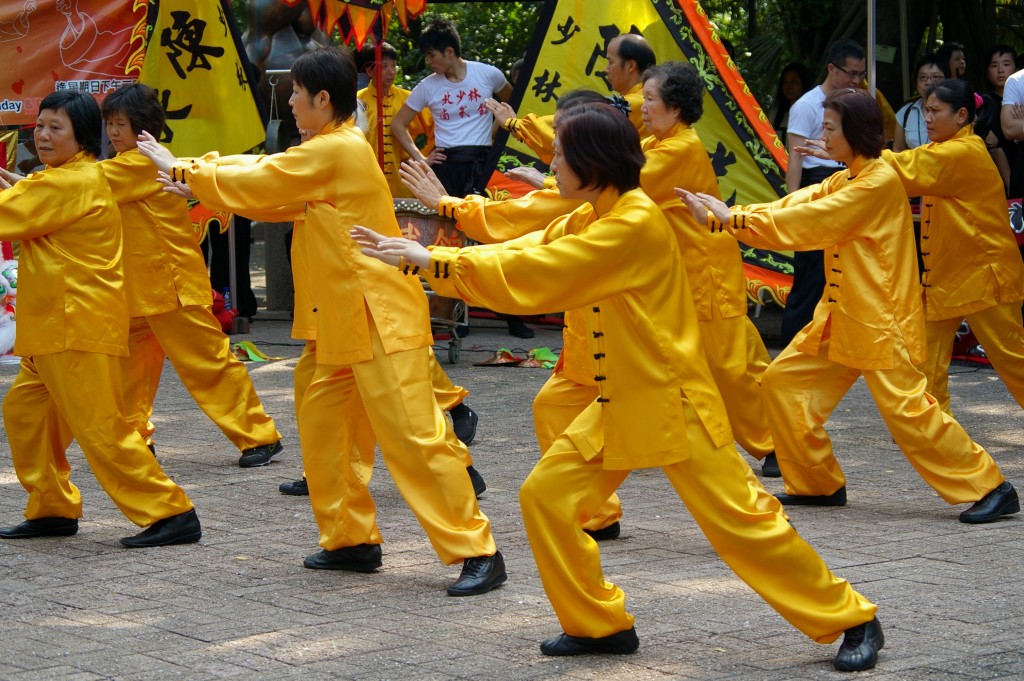
Photo by Jakub Haiun
Yet tai chi has been translated as “supreme ultimate fist” and “great extremes boxing.” As practitioners like Sophia Delza understood, tai chi’s slow pace represents control-not weakness. Mastering the movements allows devotees to develop strength, balance, and a unity between mind and action. This is useful for both longevity and self-defense-and tai chi training that involves sparring and weapons.
A pioner
In the 1950s, Eastern martial arts, and particularly tai chi, were not well known. Sophia Delza’s 1954 performance at the Museum of Modern Art was likely the first public demonstration of tai chi in the United States. Delza had studied tai chi with a master of the Wu style while living in China. When she taught, demonstrated, and wrote about tai chi on her return to the United States, she was one of the first, if not the first, to do so extensively outside Chinese-American communities.
This makes Sophia Delza a pioneer of American tai chi. Although she never achieved the fame of martial arts legends like Bruce Lee, she is worth remembering. Like tai chi, she had a gentle side that hid a powerful will. Delza loved dance, wrote academically, and de-emphasized the martial applications of tai chi. She was also one tough lady: Although American women did not have the right to vote until Delza was 17-years-old, she engaged in radical politics that made her a federal person of interest, and burst through barriers to forge a career in dance and, ultimately, as a mother of American martial arts.
Well-Behaved Women Seldom Make History
Long before Peggy Olson broke the glass ceiling at the Sterling Cooper ad agency in Mad Men, Sophia Delza  lived the mantra “well-behaved women seldom make history.”
lived the mantra “well-behaved women seldom make history.”
Delza was born in Brooklyn in 1903, an environment likely to produce an artist, but not a martial artist. She majored in the sciences at Hunter College, a women’s college, but pursued dance due to the influence of her older sister Elizabeth, who became a professional dancer and Sophia’s first dance teacher.
When Sophia followed her sister’s footsteps, she had to compete for a limited number of professional dance opportunities. She took a variety of jobs in plays and films until she triumphed with her successful solo performance at the Guild Theater in New York. When she next performed a series of original compositions, a New York Times reviewer praised her “strong feeling for visual line” and “general good taste.” Delza also developed a performance style that mixed monologues and dance, studied composition in Paris, and traveled to Mexico to study folk dances.
Her career was remarkable in an era when less than a third of women worked. It is downright daring when you consider that her work was very political-and that she kept at it despite the risk of rabid anti-communist backlash.
Delza did not study folk dance in Mexico merely out of artistic interest. According to scholar Ellen Graff, Delza associated with a close community of artists who supported socialist and communist causes. Delza studied folk dance to make a proletariat argument for embracing traditional dances by describing them as “mass dances” that could unite communities. When civil war broke out in Spain in 1936-and became a cause celebre among artists and intellectuals-Delza created and performed works that criticized the fascism of General Franco and raised money for the leftist forces in Spain that opposed him. Later in her life, Delza donated time in her dance studio to radical dance groups.
Today communism and socialism are only associated with the failings of the Soviet Union, but in the 1920s and 1930s, they represented progressive politics. The American Communist Party organized marches of tens of thousands to advocate for the unemployed. Nearly every intellectual, including George Orwell and Ernest Hemingway, admired or supported socialism.
The 1920s was also the beginning of the Red Scare and apocalyptic fears over the spread of communism in America. Both Sophia and her sister Elizabeth were the subjects of reports for the House Un-American Activities Committee, which investigated “disloyalty” and “subversive activities” among American citizens and leftist groups. Sophia’s brother Leo Hurwitz (Sophia had adopted Delza as a stage name), an award-winning documentary filmmaker, also appeared in the reports and was blacklisted by the film industry in the 1950s due to his political views.
This opposition to radical politics does not seem to have stopped Sophia or her siblings. In an interview, Sophia’s nephew explained that Sophia and his father Leo “felt… that they really could change the world.” The Communist Party in America, he continued, “spanned progressive causes like the desire to fight Fascism as it was growing in Europe, the growth of unions, the desire to stop people from being evicted from their houses, and the movement for racial justice.”East Meets West
In 1948, at age 45, Sophia Delza was married and moved to Shanghai with her husband, Cook Glassgold. China was recovering from its occupation during World War II, and Glassgold had a diplomatic posting as Director of International Refugee and Relief Operations. During the couple’s four year stay, however, Delza did much more than appear on her husband’s arm at official functions.
Delza engaged in a vigorous cultural exchange. She taught modern dance, which was novel in China, and studied and learned Chinese dance and theater. Her zeal for exploration changed her life during a trip to Beijing, where she discovered tai chi. Delza later wrote about the dramatic scene she stumbled upon at dawn in T’ai Mizo Park:
Dozens of people, young and old, were each doing his exercise, each clearly centered on himself. No outside sound of voice or instrument directed the movement. The slow, continuous flow of form and the impeccably even tempo seemed to come not only from some mastey within each one but also from the intrinsic nature of the action itself.
Delza was fascinated. “Looking amazingly light and stable at the same time,” she recalled, “each person’s movements seemed effortless.”
In context, it seems obvious that a modern dancer would be one of the first outsiders to appreciate tai chi. When Delza described her “first unforgettable impression” of the Chinese Theater in Peking, she wrote, “The colorful creatures moved so quickly that it seemed the stage itself were revolving.” Her recollection of the next scene marvels at the same slow, graceful aspects that struck her when she saw tai chi:
A simple, elegant figure, entering from the upstage right corner, quietly took a deliberate pose. He balanced himself on one leg, and extended the other in easy lightness, head high. Then replacing his leg in slow motion, he moved diagonally across the stage with the restraint and simplicity and… grace of a fairy-tale god.
At the Beijing park that morning, Delza quickly realized that “it was not dance [she]was seeing.” Yet she wanted to know more. She was introduced to Ma Yueh-liang, a famed teacher of tai chi in the Wu style, and his wife Wu Ying-hua, his co-instructor. She convinced the couple to teach her, and took up regular practice.
As Ben Judkins notes in a blog post about Sophia Delza, this put her in the unique situation of receiving several years of training “directly from one of the most talented martial artists of his generation.” She came to appreciate how, in her words, maintaining “a consistently slow tempo” in tai chi “is an indication, not only that the body has acquired strength and control, but also that the mind is in harmony with the action.”
When Delza and her husband returned to New York in 1951, she had trained for years with a foremost authority on Wu tai chi, and knew more about the practice and philosophy of tai chi than almost any American.
Introducing Tai Chi to America
In the 1950s, the practice of Eastern martial arts existed in the United States, but it was not widespread.
Hundreds of thousands of mainly Chinese immigrants passed through San Francisco’s Angel Island from 1910 to 1940, bringing with them martial arts like tai chi and judo. American soldiers stationed in Japan after the war returned to open dojos. Gene Lebell-who is now a mixed martial artist famous for teaching Chuck Norris and allegedly choking out Steven Seagal until he soiled himself-won an amateur National Judo Championship held in the United States in 1954.
But Americans like Lebell-who learned Eastern martial arts despite being outsiders to Asian communities-were rarities. Choy Hok Pang, a well-known, early teacher of tai chi in 1940s America, taught almost entirely Chinese students until the 1960s. It was not until Bruce Lee and Hong Kong “kung fu” films exploded in popularity in the 1970s that Americans widely adopted martial arts training. Some casual histories of tai chi simply write that it was introduced to the United States in the 1970s.
When Delza returned to New York from China in 1951, it was in this environment in which martial arts, and particularly tai chi, were known but relatively unfamiliar outside Asian communities.

The cover of Sophia Delza’s book, the first tai chi book published in English
Delza acted as a cultural emissary on her return, lecturing, writing, and teaching tai chi and Chinese theatre. Ultimately tai chi became her main focus.
The initial response was modest. One early student at the tai chi school Delza opened in New York regretfully recalled that her classes were poorly attended. When Delza performed tai chi at the Museum of Modern Art, it was the first demonstration of its kind, but also seems to have been a minor event. The demonstration does not turn up in the MoMA’s archived schedules from 1954, and one author credits Delza with giving the first public demonstration of tai chi in the United States two years later at the United Nations.
This did not deter Delza, who kept teaching and writing. In 1961, she published the first English language book about tai chi. As the popularity of tai chi and martial arts increased in the 1960s, partially thanks to her efforts, she appeared on television and her tai chi school thrived.
Her influence in the 1960’s
Her influence can be seen in a 1960 Popular Mechanics article about tai chi that is unmistakably a trend piece. The author-who breathlessly writes that “In Shanghai, where matches have been held, no Western boxer has yet beaten a boxer who trained on T’ai Chi to get balance and power”-makes Sophia Delza the focus of his article. He notes that her television appearances result in hundreds of inquiries from around the country, and that her students include “stage and screen stars.” Another article from 1963 relates that tai chi schools are overflowing with more students than teachers like Sophia Delza can handle.
If Bruce Lee-who more than anyone popularized martial arts in America through karate competitions and action films-was a Hollywood blockbuster or comic book, then Sophia Delza was an art film or New Yorker article. Delza taught from a studio in Carnegie Hall, which members of the Actor’s Guild could attend for free, and instructed celebrities and famous actors. In a move that foreshadowed Americans’ adoption of yoga purely as an exercise, Delza de-emphasized the martial aspects of tai chi in favor of its health and concentration benefits. Yet she always retained her academic bent, writing about the philosophy and history of tai chi in journals and books.
Sophia Delza’s role was to be one of the first advocates for tai chi, and to translate it for a non Chinese-American audience. At a time when articles marvelled at an exercise that did not involve barbells, medicine balls, or even sweat, Delza told her students that “We in the West are apt to overexert ourselves in exercise and sports, believing that a hard, tense movement indicates strength.” In tai chi, she continued, true strength, energy, and balance comes from exercise that does not strain the muscles or leave one winded.
Delza also lamented that “Too often I am asked no question other than whether this or that movement will make one thin.” She challenged her American students to appreciate other benefits of exercise, including the mental challenge of perfecting the tai chi postures.
Despite her academic inclinations, Sophia Delza is remembered as a teacher more than a scholar. Today, former students leave warm comments on blog posts about Delza that praise her instruction. One man who studied with Delza when she was in her eighties remembered her as “a tough lady” who taught tai chi “the same way a ballet master would teach.”
In 1996, Sophia Delza passed away. It had been almost 50 years since she first saw tai chi performed at dawn in T’ai Mizo Park, and she had spent over three decades as an instructor. When Delza published her first book in 1961, she had to explain every aspect of tai chi. The year she died, the State University of New York Press published her final book on tai chi. By then, it was almost impossible to imagine an America where people did not know about tai chi or martial arts. Few people know it, but that is Sophia Delza’s legacy.
A guest post from www.udemy.com – We’re the world’s online learning marketplace, where 8 million+ students are taking courses in everything from programming to yoga to photography–and much, much more. Each of our 32,000+ courses is taught by an expert instructor, and every course is available on-demand, so students can learn at their own pace, on their own time, and on any device.

